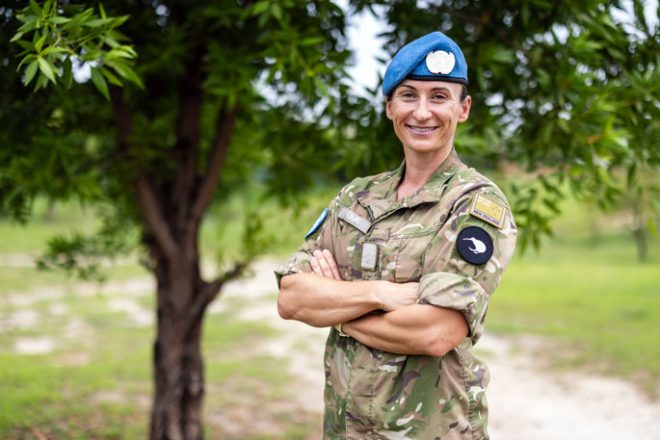Trung tá Emily Hume và nhóm của cô ở Nam Sudan đang làm việc chăm chỉ để chuẩn bị cho một cuộc bầu cử quan trọng sắp tới trong khi cũng cố gắng ngăn chặn một cuộc khủng hoảng nhân đạo ở phía bắc đất nước. Nam Sudan, một quốc gia châu Phi, đang đối phó với nhiều vấn đề bao gồm bất ổn chính trị, nội chiến, khủng hoảng nhân đạo, xung đột sắc tộc và bộ lạc, và các vấn đề kinh tế.
Phái bộ Liên Hợp Quốc tại Nam Sudan, là sứ mệnh gìn giữ hòa bình lớn nhất thế giới, có khoảng 18.000 nhân viên. Trung tá Hume, người đến từ New Zealand, là sĩ quan cấp cao cấp quốc gia trên mặt đất. Cô phụ trách phúc lợi của đội New Zealand, làm việc với các đối tác quân sự từ các quốc gia khác, Cảnh sát Liên Hợp Quốc, dân thường Liên Hợp Quốc và các cơ quan nhân đạo. Mục tiêu của họ là giám sát các thỏa thuận hòa bình, bảo vệ dân thường và giúp cung cấp viện trợ.
Trung tá Hume đã được triển khai ở nước ngoài ba lần, với các nhiệm vụ trước đó ở quần đảo Solomon và Lebanon. Bây giờ, ở tuổi 36, bà là phó giám đốc phụ trách kế hoạch dài hạn cho 14.000 quân nhân Liên Hợp Quốc ở Nam Sudan. Cô cũng liên lạc với các đội trên khắp Nam Sudan, trụ sở phái bộ và trụ sở Liên Hợp Quốc ở New York.
Một trong những nhiệm vụ đầu tiên của cô ở Nam Sudan là dẫn đầu một nghiên cứu để xem liệu phái bộ có đủ nguồn lực quân sự để hoàn thành nhiệm vụ của mình hay không. Kinh nghiệm này đã giúp cô hiểu sâu hơn về những thách thức mà các đội phải đối mặt trên mặt đất, bao gồm đối phó với căng thẳng gia tăng ở một quốc gia có cơ sở hạ tầng hạn chế và không có hệ thống cảnh báo sớm.
Phần khó khăn nhất trong việc triển khai của cô là nhìn thấy sự nghèo đói và khó khăn mà nhiều người Nam Sudan đang sống. Bà nói rằng khoảng 8,3 triệu trong số 11 triệu người ở nước này phụ thuộc vào viện trợ nhân đạo. Tình hình này đã trở nên tồi tệ hơn kể từ khi xung đột nổ ra ở nước láng giềng Sudan vào tháng Tư.
Liên Hợp Quốc đang nỗ lực ngăn chặn một cuộc khủng hoảng nhân đạo ở các khu vực gần Sudan, nơi đã chứng kiến sự gia tăng số người trở về Nam Sudan, người tị nạn và những người di tản trong nước chạy trốn bạo lực. Đồng thời, họ đang chuẩn bị cho cuộc tổng tuyển cử đầu tiên của đất nước kể từ khi giành được độc lập vào năm 2011, dự kiến sẽ diễn ra vào năm tới.
Trung tá Hume tin rằng điều quan trọng đối với New Zealand là hỗ trợ Nam Sudan vì cuộc sống rất khó khăn đối với nhiều người ở đó. Cô nói rằng phần bổ ích nhất trong công việc của cô là nhìn thấy tác động tích cực của Liên Hợp Quốc đối với cộng đồng, cho dù đó là cung cấp nước sạch, hỗ trợ các trường học địa phương, xây dựng lại nhà tù hoặc buộc mọi người phải chịu trách nhiệm về hành động của họ.
New Zealand đã hỗ trợ các nỗ lực hòa bình ở Nam Sudan thông qua sứ mệnh này từ năm 2011. Trước khi Nam Sudan độc lập, New Zealand cũng đóng góp nhân sự cho Phái bộ Liên Hợp Quốc tại Sudan từ năm 2005 đến năm 2011.






























































